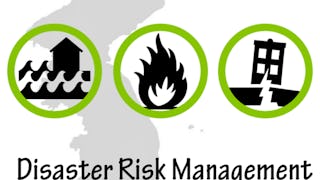This course will teach you how to identify and analyze the risks of natural disasters in infrastructure projects. You will learn about different types of qualitative and quantitative analysis, as well as the methodologies and tools used to conduct these analyses in order to apply the knowledge. You will review risk models and comprehensive risk management.


Qualitative and Quantitative Analysis of Disaster Risk
This course is part of Natural Disaster and Climate Change Risk Assessment Specialization


Instructors: Claudia Useche
8,234 already enrolled
Included with
(69 reviews)
What you'll learn
Identify key aspects of qualitative and quantitative analysis of natural disaster risks in infrastructure projects.
Recognize methodologies and tools that enable qualitative and quantitative analysis of natural disaster risks.
Identify cases where qualitative and quantitative analysis of disaster risks is required in infrastructure projects.
Skills you'll gain
Details to know

Add to your LinkedIn profile
10 assignments
See how employees at top companies are mastering in-demand skills

Build your subject-matter expertise
- Learn new concepts from industry experts
- Gain a foundational understanding of a subject or tool
- Develop job-relevant skills with hands-on projects
- Earn a shareable career certificate

There are 2 modules in this course
This course addresses the qualitative and quantitative methodology for disaster risk management in infrastructure projects, using best practices, examples, and case studies. We will explore the importance of both types of analysis and the benefits of complementing one with the other depending on the needs of each situation. Additionally, we will delve into each methodology with recommended tools such as the failure mode identification process, fault trees, and event trees to capture the complexity of system responses.
What's included
8 videos11 readings6 assignments1 discussion prompt1 plugin
What's included
6 videos19 readings4 assignments1 plugin
Earn a career certificate
Add this credential to your LinkedIn profile, resume, or CV. Share it on social media and in your performance review.
Instructors

Offered by
Explore more from Environmental Science and Sustainability
 Status: Free Trial
Status: Free TrialBanco Interamericano de Desarrollo
 Status: Free Trial
Status: Free TrialBanco Interamericano de Desarrollo
 Status: Free Trial
Status: Free TrialBanco Interamericano de Desarrollo
 Status: Preview
Status: PreviewYonsei University
Why people choose Coursera for their career





Open new doors with Coursera Plus
Unlimited access to 10,000+ world-class courses, hands-on projects, and job-ready certificate programs - all included in your subscription
Advance your career with an online degree
Earn a degree from world-class universities - 100% online
Join over 3,400 global companies that choose Coursera for Business
Upskill your employees to excel in the digital economy
Frequently asked questions
During this course, you will have access to two trial versions of different programs developed by iPresas. These programs allow for the analysis and study of various aspects of risk in infrastructure, which will be used for optional case studies presented during the course.
Please note that these programs only work on Windows-based computers. You need to have administrator permission to install them, and you may receive alerts regarding unfamiliar software during the installation process.
Minimum requirements for installation: Windows 7, 8.1, or 10.
To access the course materials, assignments and to earn a Certificate, you will need to purchase the Certificate experience when you enroll in a course. You can try a Free Trial instead, or apply for Financial Aid. The course may offer 'Full Course, No Certificate' instead. This option lets you see all course materials, submit required assessments, and get a final grade. This also means that you will not be able to purchase a Certificate experience.
When you enroll in the course, you get access to all of the courses in the Specialization, and you earn a certificate when you complete the work. Your electronic Certificate will be added to your Accomplishments page - from there, you can print your Certificate or add it to your LinkedIn profile.
More questions
Financial aid available,

